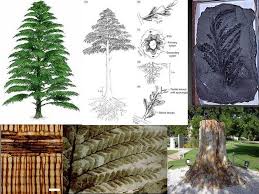Progymnosperms – Botany Notes – For W.B.C.S. Examination.
প্রোজিমনোস্পার্মস – উদ্ভিদ নোট – WBCS পরীক্ষা।
Botany is highly scoring optional subject in W.B.C.S. Mains exam. This is one of the optional subjects that the WBCS offers candidates in the mains exam. Not many candidates opt for it as it is a specialized subject. This article talks about Botany as an optional for the W.B.C.S. mains exam and gives a few tips to prepare for this optional. It will be difficult to any aspirants does not have a prior knowledge of Botany and Agriculture.Also, aspirants with a background in biotechnology can also opt for this optional subject.Progymnosperms (Progymnospermophyta) are represented by three orders: the Archaeopteridales, Aneurophytales, and Protopityales. In general all of these plants have a shrubby to arborescent habit with a pattern of lateral branching in which no axillary buds are produced.Continue Reading Progymnosperms – Botany Notes – For W.B.C.S. Examination.
The ultimate appendages are either dichotomously branched units, as in the Aneurophytales, or laminate leaves with dichotomous venation in the Archaeopteridales. The current consensus is that progymnosperms are paraphyletic, and the leaves of Archaeopteridales are potentially homologous with those of seed plants. The vascular system in progymnosperms consists of a eustele, a stele type that consists of strands of vascular tissue called sympodiaembedded in a parenchymatous ground tissue. These free-sporing plants produced fusiform sporangia that were borne along the adaxial or lateral surface of small axes that have been termed fertile leaves. Both homosporous and heterosporous forms are known. Although as a group the progymnosperms continue to be poorly understood, they provide the most convincing evidence of a lineage ancestral to the seed plants.
A number of Late Devonian–Permian petrified axes and impression–compression fossils have been described as incertae sedis, because their affinities cannot be accurately determined. Some of these may represent pteridosperms, but others may be progymnosperms or early fernlike plants.
Stenokoleos is used for permineralized axes that bear alternately arranged pinnae with elliptical to clepsydroid-shaped traces (FIG. 14.82). The primary xylem of the stem consists of a two- to five-lobed stele with mesarch protoxylem and weakly developed peripheral loops; tracheids are scalariform or have uni- or biseriate circular-bordered pits. In cross section, S. simplex (Late Devonian) reveals triangular traces in the rachis (Beck, 1960c). Other species, for example, S. bifidus, are distinguished based on variability in the configuration of the xylem (Matten and Banks, 1969; Matten, 1975). The ribbed primary xylem columns of S. holmesii from the Givetian Cairo flora of New York have been demonstrated to be important in the development of the trifurcate branching pattern of that plant (Matten, 1992). In many features, Stenokoleos is similar to Tristichiaand Tetrastichia. Rothwell and Erwin (1987) and Serbet and Rothwell (1992) reported on Stenokoleos-like anatomy in basal gymnosperms such as Elkinsia (FIG. 14.83), which suggests that some Stenokoleosmay represent progymnosperms (see Scheckler et al., 2006). The discovery of reproductive parts associated with these stems will demonstrate conclusively whether these axes represent lyginopterid seed ferns or some progymnosperm ancestor.To know more about W.B.C.S. syllabus , click here.
Two Early Mississippian (New Albany Shale) taxa that may ultimately turn out to be the petioles of seed ferns are Periastron (Beck, 1978; Gastaldo, 1995) and Aerocortex (Beck, 1978). Specimens of P. reticulatum vary from circular to elliptical in cross section and contain a nearly median row of 5–10 slightly curved amphicribral vascular bundles (FIG. 14.84). Tracheids have helical–reticulate secondary wall thickenings. The cortex is aerenchymatous with longitudinal lacunae (air canals) and peripheral sclerenchyma associated with secretory canals or ducts. Aerocortex kentuckiensis has many of the same features as Periastron, but with fewer vascular bundles (two to four) and centrally located secretory ducts.
Nystroemia reniformis (=pectiniformis) is a compression taxon from the Upper Permian of China (Hilton and Li, 2003; J. Wang et al., 2003). Specimens from the Upper Shihhotze Formation, Shanxi (Shansi) Province, consist of branching systems comprising at least four orders of branching. First-order axes branch to one side only and give off second-order branches either singly or in pairs, which are of two types: one fertile and bearing characteristic ovulate branching systems and the other presumably vegetative. Ovulate axes produce multiple, closely spaced slender lateral branches in two alternate to subopposite rows which bear ovulate branching systems. The ovulate branching systems produce planated ultimate axes of different lengths. Each ultimate axis bears a terminal ovule with 180° rotational symmetry and two distal hornlike integumentary projections. Additional parts of the Nystroemia plant from Shanxi include pollen organs originally described by Halle (1927, 1929) and detached Chiropteris reniformis foliage. The organic connection between N. pectiniformis ovulate axes and Chiropteris reniformis has been documented based on material from Dengfeng in Henan (J. Wang et al., 2003). Hilton and Li (2003) suggested that Nystroemiarepresents a late stratigraphic occurrence of a plesiomorphic hydrasperman-type seed plant (FIG. 14.86) with affinities closely allied to members of the Lyginopteridales.
Please subscribe here to get all future updates on this post/page/category/website


 Toll Free 1800 572 9282
Toll Free 1800 572 9282  mailus@wbcsmadeeasy.in
mailus@wbcsmadeeasy.in



















































































































